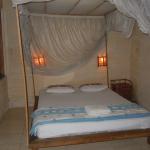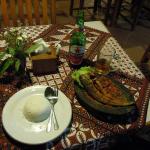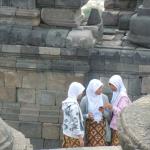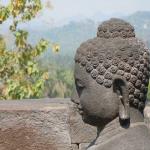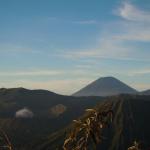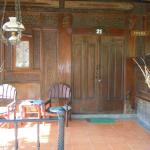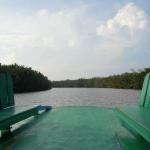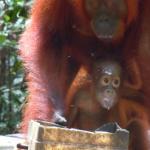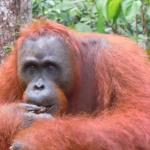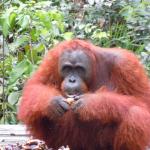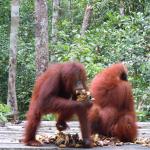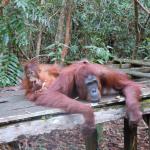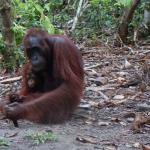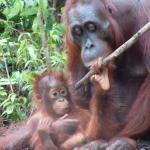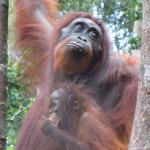© 2011 Sabrina Swenson. All Rights Reserved.
Indonesia
October, 2011
A country comprised of over 17,000 islands? Impossible, I thought, until I arrived in Indonesia. This archipelago is comprised of approximately 17,508 islands spread out from South East Asia to the Oceania region. A richly diverse country with a majority Muslim population.
I flew into the Capital of Indonesia, Jakarta. I found a hotel and as I checked into my room I laughed as the lady handed me a key along with a large, orange can of bug spray. "Well isn't that thoughtful" I thought to myself. I awoke in the morning to find my face and body covered in mosquito bites. Apparently, I had not used enough! I gathered my belongings and caught a train to the city of Yogyakarta. From here I caught a local bus the short distance to my intended destination; Borobudur. On the bus a group of young school girls boarded in their crisp uniforms and Muslin head coverings. They were all very friendly, spoke English well and asked me a million questions. They asked where I was from, what my favorite movie was, who my favorite actress was and if I knew Johnny Depp! No, I assured them, I did not know him personally... America is a big country after all! They kept the endless questions up the entire ride until they finally had to get off the bus and depart for home. Once in Borobudur I found a hotel and smiled when I opened the door to a beautiful room with a canopy bed, shiny waxed floors and wood shutters. Compared with many local places I have stayed, this was a beauty. Borobudur is the largest Buddhist monument in the world believed to have been built around the 9th century. It is a UNESCO World Heritage site. A main dome, located at the center of the top platform, is surrounded by 72 Buddha statues seated inside stupas (dome shaped monuments, used to house Buddhist relics or to commemorate significant facts of Buddhism). As I walked around the site, a large bus full of school kids arrived and I was immediately bombarded with school children all wanting to take pictures with me and wanting my "signature". For about an hour I stood in the beating sun, sweat running down my back as I posed with different kids that would move in to have their picture taken with me. All were excited to practice their English. I discovered school kids in Indonesia are very friendly, inquisitive and full of a million questions which they do not hold back! After an hour they were finally called by their teacher and were loaded back on their bus. Once they departed I got back to the business of exploring Borobudur, this time uninterrupted. The site is enormous and the stupas resemble bells in their shape. I had never seen anything quite like it, it was impressive, indeed.
After a couple days in the small village of Borobudur I caught a long bus ride to Mt. Bromo, an active volcano in East Java. It was a joy to spend an evening in a guest house half way up a volcano escaping the oppressive heat of the country. In my room that evening under layers of clothing and a heavy blanket I was thankful for the fresh, crisp air. Early the next morning after breakfast I, along with other occupants from the hotel, were picked up with Jeeps and drove to the volcano opposite Mt. Bromo. We were dropped off at the base of Mt. Penanjakan and climbed to the view point half way up to enjoy a beautiful sunrise. Mt. Bromo is surrounded by what is called the sea of sand. As such, it makes for a beautiful picture when the sun rises over it. After lingering a while we climbed back down and were driven to the foot of Mt. Bromo where we climbed up to the lip of the smoking volcano.
After Bromo, I caught another long distance bus to the island of Bali. Bali, a lush island, is home to the countries small Hindu minority. I tried Indonesia's famous Kopi Luwak coffee while in Bali. If you've seen the movie "Bucket List" perhaps you've heard of it. Kopi Luwak is most famous for where it's beans have traveled before ending up in someones coffee maker. It is made from the beans of coffee berries which have been eaten by the Asian Palm Civet (a small cat-like nocturnal mammal). The civet eats the berries which have a fleshy pulp. Once in the stomach the civet's enzymes go to work on the beans, which adds to the coffee's prized aroma and flavor Once they have thoroughly been passed through the civet the beans are gathered, thoroughly washed, dried in the sun, lightly roasted and brewed. The result is a delicious aromatic coffee. It is widely known as the most expensive coffee in the world with prices around $160 per pound. The kind man at the coffee house I stopped at gave me a small cup to taste for free. Although I thought it was pretty good, I certainly wouldn't claim it to be $160 a pound good! Another day I stopped at the Bali Bombing Memorial site that pays homage to the 202 people lost in a Bali bombing of a night club in 2002. It was beautifully done and listed the name of those who died in the terrorist attack. After a few more days in the endless sun of Bali I hopped a plane to Kalimantan or as it's better known Borneo.
Borneo is a large island that is divided among three countries; Indonesia, Brunei and Malaysia. The majority (73%) is Indonesian territory. I arrived in Borneo into the small village of Pankalang Bun and got a taxi to a small, and as I soon found out, dingy hotel. I found someone to help me organize a trip to Tanjung Puting National Park for the highlight of my trip; a journey into the swampy forests to see the orangutans.
The only way to enter Tanjung Puting National Park is by boat. I was told that speed boats not only are very noisy but also scare the wildlife and so I hired a much more pleasant, peaceful and civilized ride, the simple houseboat. It consisted of the lower level where the galley was located where my female chef made excellent meals and the upper deck were I lingered. There was a covering over most of the boat which did a fine job of blocking the sun while I sat on the deck. There was also a beautiful wooden table and chairs and a few seats up front. There was even a real toilet at the back complete with flush! I set off early in the morning with my guide, the captain and the fantastic chef. We traversed the open water until we came to a narrow pathway next to a huge "Welcome to Tanjung Puting National Park" sign replete with a gigantic picture of the star orange attraction; the orangutan. We floated for about an hour and a half until we reached the Pondok Tangui feeding station. There are three feeding stations in this National Park. Once a day, food and drink are provided for any orangutan that wishes to come and partake. The meal consists of bananas and containers of milk. We arrived at the first station and made a stroll deeper into the forest on foot. When we arrived I was disappointed to see about 13 humans but no orangutans. We sat a while and watched the jungle and after about 15 minutes, 10 people got up and left. About 2 minutes later the orangutans started to appear! At first one female and baby came to have some bananas and eventually a big guy almost twice her size appeared. I laughed as the mother and baby dunked their faces into the container of milk and after, the baby came up with a huge milk mustache. The larger male was much more orange in color than the female and had the appearance of a fresh, albeit, crooked haircut including "bangs"! Since the Tanjung Puting National Park is their natural habitat there are no fences what-so-ever. As such, I was able to go right up to the orangutans and get close-up shots of them. I was briefed by my guide, however, if an orangutan approached, I should move out of its way. Since they are eight times stronger than a human, I didn't argue. I snapped away until they were apparently full of bananas and milk and wondered off back into the forest.
In Malay orang means "person" and utan is derived from hutan, which means "forest". Thus orangutan literally means "person of the forest". Orangutans can live 30 to 50 years and although they are definitely tree-dwelling animals they do spend as much as half the day on the ground. At night they sleep in nests of sticks they build high in the treetops. They, astonishingly have DNA that is 97 percent the same as ours! There are an estimated 48,000 orangutans today which live on Borneo and another 6,5000 in Sumatra. I had seen the regal, black mountain gorillas of Uganda a few years ago. These slow moving beasts appear very regale in their large size and imposing look but the orangutans, by vast contrast, appeared to me like a scrappy, scruffy, smaller cousin with crazy, long, wild orange hair!
We walked back to the houseboat and continued a couple hours to Camp Leakey. Camp Leakey, interestingly, was named after the legendary Dr. Louis Leakey who sponsored Dr. Birute Mary Galdikas in her study of the orangatans of Borneo. Dr. Galdikas has studyed the orangatans in their natural habitat for the past 40 years and is today the world's foremost authority on the orangatan. Once we docked at Camp Leakey a smaller orangutan greated us at the entrance to the forest. Percy was his name and my guide mentioned Percy is always the first to meet any guests who arrive at Camp Leakey. He was a ham and appeared to be posing for pictures. We walked a ways through the forest to an even bigger camp complete with a jungle gym made out of the trees. Here we found lots of orangutans playing. I even saw one female walk upright on her hind legs and stand there staring at me in a scarily human stance. A little later I saw a mother with baby on her shoulder playing and when a wild bore approached she picked up a nearby stick and threw it at him. The pig ran off and she seemed satisfied with the results. As he slowly approached a second time she did the same thing but this time with more gusto and succeded in scaring him off for good. It was funny to watch them with their many human like actions. After an hour or so we headed back to the houseboat and eventually I was back in my dingy room in Pangkalan Bun.
I was sad to read that Corporations and plantations are rapidly destroying the natural rain forests where the orangutans live to plant oil palms which produce a highly lucrative crop. Palm oil is the world's number one vegetable oil. It's ingredients can be found in shampoos, toothpaste, cosmetics, margarine, chocolate bars and all manner of snacks and processed foods.
After my stay on Borneo I flew back to Jakarta and from there caught my flight home. Borobudur and the orangutans were definitely the highlight of this trip. It was an educational travel experience and a great chance to get out into nature to see the wild hair beasts!

